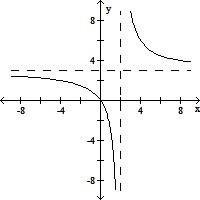For the rational function below (i) Find the intercepts for the graph; (ii) Determine the domain; (iii) Find any vertical or horizontal asymptotes for the graph; (iv) Sketch any asymptotes as dashed lines. Then sketch the graph of y = f(x).f(x) = 

A. (i) x intercept: 0; y intercept: 0
(ii) Domain: all real numbers except -2
(iii) Vertical asymptote: x = -2; horizontal asymptote: y = -3
(iv)
B. (i) x intercept: 0; y intercept: 0
(ii) Domain: all real numbers except 2
(iii) Vertical asymptote: x = 2; horizontal asymptote: y = 3
(iv)
C. (i) x intercept: 0; y intercept: 0
(ii) Domain: all real numbers except 2
(iii) Vertical asymptote: x = 2; horizontal asymptote: y = -3
(iv)
D. (i) x intercept: 0; y intercept: 0
(ii) Domain: all real numbers except -2
(iii) Vertical asymptote: x = -2; horizontal asymptote: y = 3
(iv)
Answer: B
You might also like to view...
Simplify by combining like terms.22.2x - 7.8 - 8.4x + 14.3
A. 13.8x + 6.5 B. 14.8x + 6.5 C. 13.8x + 7.5 D. 20.3x
Find the difference.18 - 
A. 17
B. 15
C. 18
D. 17
Use the fact that the trigonometric functions are periodic to find the exact value of the expression. Do not use a calculator.sin 
A. - 
B. -1
C. - 
D. 
Solve the problem.What will be the amount in an account with initial principal $5000 if interest is compounded continuously at an annual rate of 4.25% for 7 years?
A. $5000.00 B. $5217.08 C. $6732.44 D. $2173.43